Discussion
Home ‣ Non Verbal Reasoning ‣ Analytical Reasoning Comments
- Question
Determine the number of rectangles and hexagons in the given figure.

Options- A. 30, 5
- B. 32, 3
- C. 28, 5
- D. 30, 3
- Correct Answer
- 30, 5
ExplanationThe figure may be labelled as shown.Tags: AIEEE, Bank Exams, CAT, Bank Clerk, Bank PO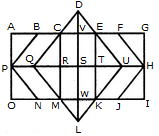
Rectangles:
The simplest rectangles are CVSR, VETS, RSWM and STKW i.e. 4 in number.
The rectangles composed of two components each are CETR, VEKW, RTKM and CVWM i.e. 4 in number.
The rectangles composed of three components each are ACRP, PRMO, EGHT and THIK i.e. 4 in number.
The rectangles composed of four components each are CEKM, AVSP,PSWO, VGHS and SHIW i.e. 5 in number.
The rectangles composed of five components each are AETP, PTKO, CGHR and RHIM i.e. 4 in number.
The rectangles composed of six components each are ACMO and EGIK i.e. 2 in number.
The rectangles composed of eight components each are AGHP, PHIO, AVWO and VGIW i.e. 4 in number.
The rectangles composed of ten components each are AEKO and CGIM i.e. 2 in number.
AGIO is the only rectangle having sixteen components.
Total number of rectangles in the given figure
= 4 + 4 + 4 + 5 + 4 + 2 + 4 + 2 + 1 = 30.
Hexagons:
The hexagons in the given figure are CDEKLM, CEUKMQ, CFHJMQ, BEUKNP and BFHJNP.
So, there are 5 hexagons in the given figure.
Analytical Reasoning problems
Search Results
- 1. Count the number of parallelogram in the given figure.

Options- A. 20
- B. 18
- C. 16
- D. 12 Discuss
Correct Answer: 18
Explanation:
The figure may be labelled as shown.
The simplest ||gms are ABFE, BCGF, CDHG, EFJI, FGKJ and GHLK. These are 6 in number.
The parallelograms composed of two components each are ACGE, BDHF, EGKI, FHLJ, ABJI, BCKJ and CDLK. Thus, there are 7 such parallelograms.
The parallelograms composed of three components each are ADHE and EHLI i.e. 2 in number.
The parallelograms composed of four components each are ACKI and BDLJ i.e. 2 in number
There is only one parallelogram composed of six components, namely ADLI.
Thus, there are 6 + 7 + 2 + 2 + 1 = 18 parallelograms in the figure.
- 2. Count the number of triangles and squares in the given figure.

Options- A. 26 triangles, 5 squares
- B. 28 triangles, 5 squares
- C. 26 triangles, 6 squares
- D. 28 triangles, 6 squares Discuss
Correct Answer: 28 triangles, 6 squares
Explanation:
The figure may be labelled as shown.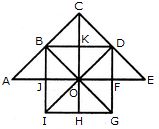
Triangles:
The simplest triangles are JBO, BKO, KDO, DFO, FGO, GHO, HIO, IJO, ABJ, BCK, CKD and DEF i.e.12 in number.
The triangles composed of two components each are IBO, BDO, DGO, GIO, ABO, CDO, CBO, CBD and DEO i.e. 9 in number.
The triangles composed of four components each are IBD, BDG, DGI, GIB, ACO and COE i.e. 6 in number.
There is only one. triangle i.e. ACE composed of eight components.
Thus, there are 12 + 9 + 6 + 1 = 28 triangles in the given figure.
Squares:
The squares composed of two components each are BKOJ, KDFO, OFGH and JOHI i.e. 4 in number.
There is only one square i.e. CDOB composed of four components.
There is only one square i.e. BDGI composed of eight components.
Thus, there are 4 + 1 + 1 = 6 squares in the given figure.
- 3. Count the number of squares in the given figure.

Options- A. 32
- B. 30
- C. 29
- D. 28 Discuss
Correct Answer: 30
Explanation:
The figure may be labelled as shown.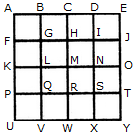
The simplest squares are ABGF, BCHG, CDIH, DEJI, FGLK, GHML, HINM, IJON, KLQP, LMRQ, MNSR, NOTS, PQVU, QRWV, RSXW and STYX i.e. 16 in number.
The squares composed of four components each are ACMK, BDNL, CEOM, FHRP, GISQ, HJTR, KMWU, LNXV and MOYW i.e. 9 in number.
The squares composed of nine components each are ADSP, BETQ, FIXU and GJYV i.e. 4 in number.
There is one square AEYU composed of sixteen components.
There are 16 + 9 + 4 + 1 = 30 squares in the given figure.
- 4. In the adjoining figure, if the centres of all the circles are joined by horizontal and vertical lines, then find the number of squares that can be formed.

Options- A. 6
- B. 7
- C. 8
- D. 1 Discuss
Correct Answer: 8
Explanation:
The figure may be labelled as shown.
We shall join the centres of all the circles by horizontal and vertical lines and then label the resulting figure as shown.
The simplest squares are ABED, BCFE, DEHG, EFIH, GHKJ and HILK i.e. 6 in number.
The squares composed of four simple squares are ACIG and DFLJ i.e. 2 in number.
Thus, 6 + 2 = 8 squares will be formed.
- 5. How many circles are there in the adjoining figure.
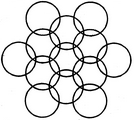
Options- A. 11
- B. 12
- C. 13
- D. 14 Discuss
Correct Answer: 13
Explanation:
The figure may be labelled as shown.
There are 13 circles in the given figure. This is clear from the adjoining figure in which the centres of all the circles in the given figure have been numbered from 1 to 13.
- 6. Count the number of triangles and squares in the given figure.
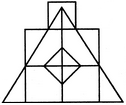
Options- A. 21 triangles, 7 squares
- B. 18 triangles, 8 squares
- C. 20 triangles, 8 squares
- D. 22 triangles, 7 squares Discuss
Correct Answer: 21 triangles, 7 squares
Explanation:
The figure may be labelled as shown.
Triangles :
The simplest triangles are BPN, PNE, ABM, EFG, MLK, GHI, QRO, RSO, STO and QTO i.e. 10 in number.
The triangles composed of two components each are BPE, TQR, QRS, RST and STQ i.e. 5 in number.
The triangles composed of three components each are MPO and GPO i.e. 2 in number.
The triangles composed of six components each are LPJ, HPJ and MPG i.e. 3 in number.
There is only one triangle LPH composed of twelve components.
Total number of triangles in the figure = 10 + 5 - 2 + 3 + 1 = 21.
Squares :
The squares composed of two components each are KJOM and JIGQ i.e. 2 in number.
The squares composed of three components each are ANOM, NFGO and CDEB i.e.3 in number.
There is only one square i.e. QRST composed of four components.
There is only one square i.e. AFIK composed of ten components.
Total number of squares in the figure = 2 + 3 + 1 + 1 = 7.
- 7. Find the number of quadrilaterals in the given figure.

Options- A. 6
- B. 7
- C. 9
- D. 11 Discuss
Correct Answer: 11
Explanation:
The figure may be labelled as shown.
The quadrilaterals in the figure are ABCD, ABDE, ABDF, ABDH, CDHA, CDEA, CDFA, DEAG, DEFA, FAGD and AGDH.
The number of quadrilaterals in the figure is 11.
- 8. Count the number of squares in the given figure.

Options- A. 8
- B. 12
- C. 15
- D. 18 Discuss
Correct Answer: 15
Explanation:
The figure may be labelled as shown.
The simplest squares are QUYX, URVY, YVSW and XYWT i.e. 4 in number.
The squares composed of two components each are IMYP, MJNY, YNKO and PYOL i.e. 4 in number.
The squares composed of three components each are AEYH, EBFY, YFCG and HYGD i.e. 4 in number.
There is only one square i.e. QRST composed of four components.
There is only one square i.e. IJKL composed of eight components.
There is only one square i.e. ABCD composed of twelve components.
Total number of squares in the given figure = 4 + 4 + 4+1 + 1 + 1 = 15.
- 9. Count the number of squares in the given figure.

Options- A. 6
- B. 7
- C. 9
- D. 10 Discuss
Correct Answer: 9
Explanation:
The figure may be labelled as shown.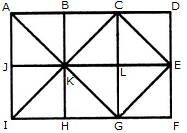
The squares composed of two components each are ABKJ, BCLK, CDEL, LEFG, KLGH and JKHI i.e.6 in number.
There is only one square i.e. CEGK composed of four components.
The squares composed of eight components each are ACGI and BDFH i.e. 2 in number.
There are 6 + 1 + 2 = 9 squares in the figure.
- 10. What is the minimum number of colours required to fill the spaces in the given diagram without any two adjacent spaces having the same colour?

Options- A. 6
- B. 5
- C. 4
- D. 3 Discuss
Correct Answer: 3
Explanation:
The figure may be labelled as shown.
The spaces P, Q and R have to be shaded by three different colours definitely (since each of these three spaces lies adjacent to the other two).
Now, in order that no two adjacent spaces be shaded by the same colour, the spaces T, U and S must be shaded with the colours of the spaces P, Q and R respectively.
Also the spaces X, V and W must be shaded with the colours of the spaces S, T and U respectively i.e. with the colours of the spaces R, P and Q respectively. Thus, minimum three colours are required.
Comments
There are no comments.
Programming
Copyright ©CuriousTab. All rights reserved.
- 1. Count the number of parallelogram in the given figure.
